Mazda’s “Sustainable Zoom-Zoom 2030” Vision
Part 2: What is the Multi-Solution approach?
Mazda announced its “Sustainable Zoom-Zoom 2030” long-term vision for technology development on August 8, 2017.
News Releases:Mazda Announces Long-Term Vision for Technology Development, 'Sustainable Zoom-Zoom 2030'
http://www2.mazda.com/en/publicity/release/2017/201708/170808a.html

This two-part series will provide an in-depth review of the “Sustainable Zoom-Zoom 2030” vision, with a specific focus on Mazda’s approach to problems facing the earth.
Looking ahead to 2030, we said we would advance our initiatives to substantially reduce carbon dioxide (CO2) emissions in line with the well-to-wheel concept, which also takes into account emissions generated by energy extraction, production and transportation.
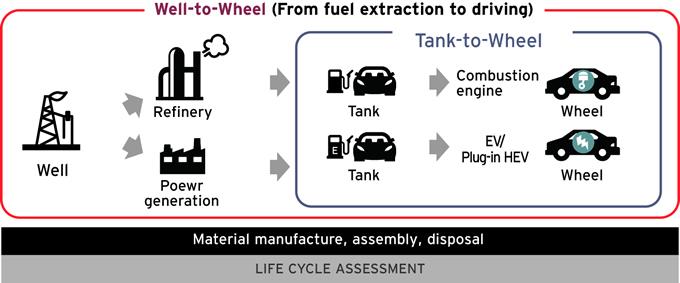
In Part 2, we will discuss the Multi-Solution concept behind Mazda’s next-generation technology introduction plan that builds on the well-to-wheel concept. You may wonder, “Will Mazda ever sell electric vehicles?” or “What will happen to combustion engine-powered cars?” We hope to answer some of these questions here.
Before we get started, let’s quickly recap Mazda’s approach to issues facing the earth.
Through conservation initiatives, we aim to create a sustainable future in which people and cars coexist with a bountiful, beautiful earth.
Specifics of Mazda’s approach
- Expand measures for reducing CO2 emissions from a well-to-wheel perspective, considering emissions over the vehicle's entire life cycle.
- Aim to reduce Mazda’s corporate average well-to-wheel CO2 emissions to 50 percent of 2010 levels by 2030, with an eye to achieving a 90-percent reduction by 2050.
- This goal will require a Multi-Solution approach that offers appropriate powertrains in consideration of each country or region’s energy policies and energy mix.
-Mazda’s policy is to maximize improvements to fuel efficiency and clean emissions in real-world conditions.
In line with this policy, we will keep working to perfect the internal combustion engine, which is forecast to help power the majority of cars worldwide for many more years and can therefore make the greatest contribution to reducing CO2 emissions. We will combine these efforts with effective electrification technologies.
From 2019, we will start introducing EVs and other electric drive technologies in regions with abundant clean energy and regions that restrict certain vehicle types to reduce air pollution.
Blog: Mazda’s “Sustainable Zoom-Zoom 2030” Vision Part 1: The Well-to-Wheel Concept
ttps://www.mazda.com/en/notification/20190225/
Launch plan for next-generation technologies
First, we will talk about our plans to launch next-generation technologies. In order to achieve our “Sustainable Zoom-Zoom 2030” goals, we plan to introduce our next-generation technologies in line with the schedule below.
Fig.1

We plan to introduce the next-generation Skyactiv-X engine and hybrids from 2019; the second-generation Skyactiv-D diesel engine and a battery EV in 2020; and plug-in HEVs from 2021.
Unique to Mazda, Skyactiv-X is a new kind of internal combustion engine (Fig. 2) that combines the advantages of both gasoline and diesel engines. It achieves excellent environmental performance without compromising power and acceleration performance.
Fig. 2
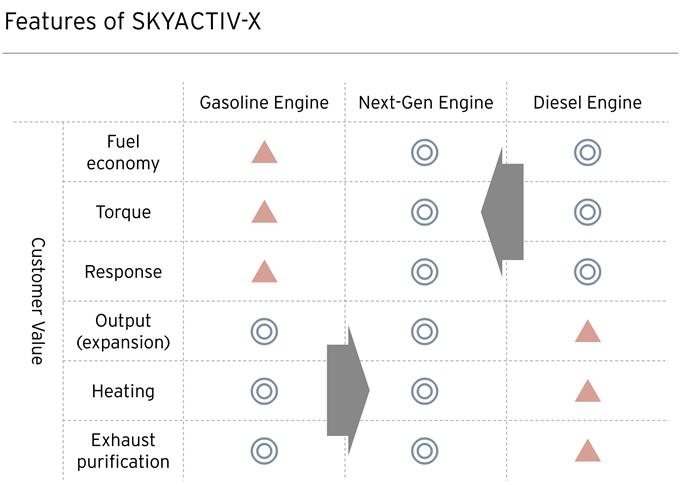
In fact, engine performance is significantly improved. Compression ignition results in a swift engine response hitherto unknown in a gasoline engine, and a supercharger is fitted to improve fuel efficiency. Skyactiv-X will provide a significant boost in torque over our current Skyactiv-G; we expect an improvement of 10-30 percent, depending on rpms.
In terms of environmental performance, fuel consumption is reduced by 35-45 percent compared to our gasoline engine of the same displacement from 2008.* Fuel consumption in Skyactiv-X is 20-30 percent lower than in Skyactiv-G and equal to or better than the latest Skyactiv-D.
* As of August 2017, based on Mazda’s testing during development
The future of the internal combustion engine
What do you think will become of internal combustion engines such as gasoline, diesel and Skyactiv-X in the future? The chart below shows the forecast global spread of different vehicle power units, including engines and motors (Fig. 3).
Fig. 3

Global car sales are predicted to continue to rise due to increasing demand in emerging economies. Sales of vehicles equipped with only an internal combustion engine will peak around 2020 before starting to decrease.
But don’t forget that hybrids and plug-in hybrids also require an internal combustion engine. As such, even as far ahead as 2030, cars with combustion engines will still comprise about 90 percent of global vehicle sales. In other words, demand for the car’s most fundamental technology, the internal combustion engine, will remain high for many years to come.
What is the Multi-Solution approach?
With “Sustainable Zoom-Zoom 2030,” we are looking ahead to the year 2030, and it’s clear that even then demand for internal combustion engines will still be high. And as we said in the previous post regarding the well-to-wheel concept, it’s also important to consider that EVs and plug-in hybrids need to be charged, and that the power generation mix (the ratio electricity produced by renewable, nuclear and fossil fuels) is different in each country or region. Finally, automakers must meet different regulations in each country and respond to the various ways in which people use their vehicles, from short trips around town to long-distance journeys with a trunk full of luggage.
Taking all of these factors into consideration, Mazda’s Multi-Solution approach offers a selection of power units (including combustion engines and electrification technologies) tailored to the needs of each market. Through this approach, Mazda will contribute to the resolution of environmental issues facing the planet.
Technology strategy for realizing the Multi-Solution approach
What is Mazda’s technology strategy to realize its Multi-Solution approach? It is the Building Block Strategy, as shown in Fig. 4.
Fig. 4
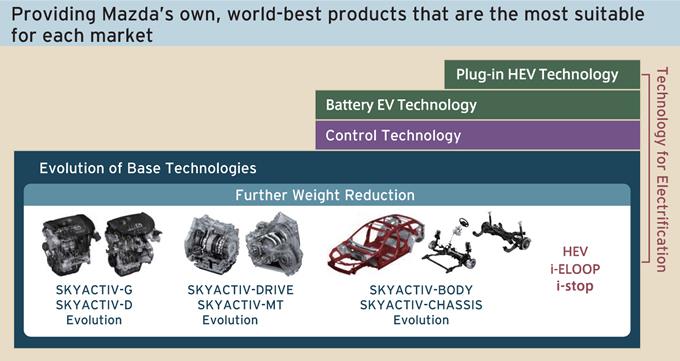
With the Building Block Strategy, we first improve the base technologies that provide the vehicles’ basic performance, including the engine, transmission, body and chassis. (These are what we call our Skyactiv technologies.) Then, we add electric devices, such as idling stop, brake energy regeneration and hybrid systems. This approach enables us to provide customers around the world with cars that offer excellent environmental and safety performance at affordable prices, without having to rely heavily on a single power unit.
By further combining battery EV technology and plug-in HEV technology, we can make even greater contributions to our environment.
What are the benefits of electrification?
So, what are the advantages of electrification? The table below (Fig. 5) sums up the characteristics of each type of power unit.
Fig. 5
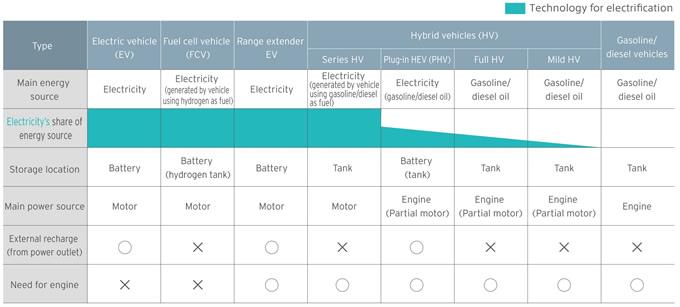
One benefit is that the car’s kinetic energy can be easily converted into electrical energy when braking. In a hybrid vehicle, this regenerated energy can be used to power an electric motor that assists the engine at low rpms, where combustion engines tend to be less efficient. Energy output can be finely controlled according to engine rpms and other factors, leading to further reduction in CO2 emissions.
In many cases, terms such as “electrification” or “electric-drive” are used to describe any vehicle in which electricity is used to provide motive force. As such, “electric-drive” is not limited to purely electric vehicles (EVs). Recently, a number of countries have said that they intend to increase sales of electric-drive cars. We believe that in most cases, this wider definition is being applied. As we saw in Fig. 3 above, sales of hybrids and plug-in hybrids, which also feature internal combustion engines, are forecast to keep growing in the future.
In conclusion
In order to make a meaningful contribution to the global environment, we think it’s important to consider CO2 emissions over the car’s entire life cycle (well-to-wheel) and to offer appropriate products in light of each country’s policies and power generation mix (Multi-Solution approach). Mazda aims to achieve its “Sustainable Zoom-Zoom 2030” vision by launching cars with power units (combining base technologies and electric devices) tailored to each market. Above all, together with our customers, who love cars and cherish the pleasure of driving, Mazda is committed to building a future in which people and cars can co-exist with a bountiful, beautiful earth.
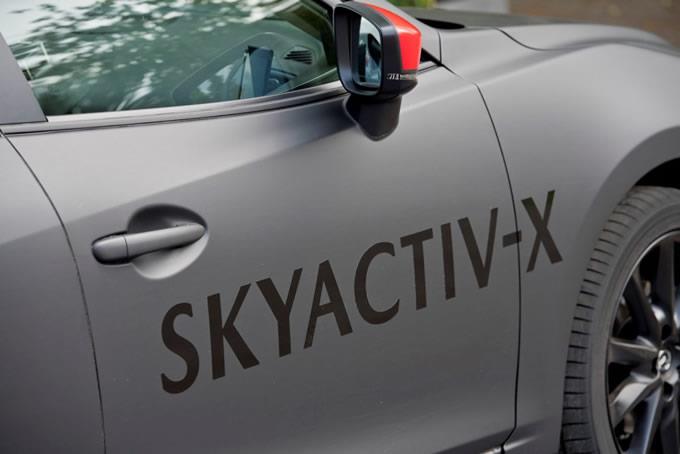
We hope this post has deepened your understanding of Mazda’s “Sustainable Zoom-Zoom 2030” vision, especially our approaches to issues facing the earth.
■ Video: Briefing on Mazda’s Long-Term Vision for Technology Development
https://www.youtube.com/watch?v=-RN9WWtDgzQ
■ Video: Next Generation Gasoline Engine SKYACTIV-X: Technology Intro Film
https://www.youtube.com/watch?v=b7NaczesuE0
■ Video: Next-generation Skyactiv-X gasoline engine: SPCCI
https://www.youtube.com/watch?v=RBlBrxT-Xy4
